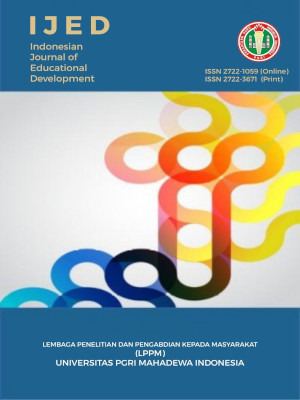Development of a mathematics teaching module based on the APOS model integrated with GeoGebra
DOI:
https://doi.org/10.59672/ijed.v6i2.5217Keywords:
APOS, GeoGebra, Quadratic function, Teaching moduleAbstract
This study aims to develop a mathematics teaching module based on the APOS (Action, Process, Object, Schema) model integrated with GeoGebra, focusing on the topic of quadratic functions for tenth-grade students at SMAN 1 Muara Beliti. The research employed the Plomp development model, which consists of five phases: preliminary investigation, design, construction, validation, and limited testing. The module was developed under the cognitive stages of the APOS model: action, process, object, and schema, and was enhanced through visual exploration using GeoGebra. The research subjects consisted of tenth-grade students and a mathematics teacher at SMAN 1 Muara Beliti, selected through purposive sampling. Data were collected through documentation, expert validation sheets, and practicality questionnaires completed by the teacher and students. The findings indicate that the developed module is highly needed by students and significantly addresses their difficulties in understanding mathematical concepts. Expert validation yielded an average score of 87.85%, classified as highly valid. Practicality testing produced scores of 92.50% from the teacher and 90.41% from the students, both categorized as highly practical. Thus, the module facilitates interactive, conceptual, and contextual learning aligned with the principles of the Independent Curriculum. Accordingly, it is deemed a feasible and innovative instructional resource for high school mathematics learning.
Downloads
References
Anggraeni, E. R., Ma’rufi, M., & Suaedi, S. (2021). Pengembangan Media Pembelajaran Matematika Berbasis Geogebra Untuk Meningkatkan Kemampuan Pemahaman Konsep Siswa. Proximal: Jurnal Penelitian Matematika Dan Pendidikan Matematika, 4(1), 43–55. https://doi.org/10.30605/proximal.v4i1.503
Antasari, M., Hanifah, H., Susanta, A., & Andriani, I. (2023). Penerapan pendekatan realistic mathematics education melalui model APOS berbantuan GeoGebra untuk meningkatkan hasil belajar matematika. AKSIOMA: Jurnal Program Studi Pendidikan Matematika, 12(2), 2468. https://doi.org/10.24127/ajpm.v12i2.6928
Anto, Y., Zurweni, Z., & Harjono, H. S. (2024). Development of interactive multimedia based on local wisdom of Jambi oriented by students’ creative thinking ability in high school physics subjects. Indonesian Journal of Educational Development (IJED), 5(1), 137–149. https://doi.org/10.59672/ijed.v5i1.3734
Arifin, I., Zurweni, Z., & Habibi, A. (2024). A development of interactive e-modules for high school physics learning based on problem based learning (PBL). Indonesian Journal of Educational Development (IJED), 5(1), 51–67. https://doi.org/10.59672/ijed.v5i1.3698
Asdarina, O., & Khatimah, H. (2021). Berbantuan aplikasi GeoGebra pendidikan matematika. E-Journal Pendidikan Matematika, 10(2), 860–871.
Budiarti, C. D., Purwanto, S. E., & Hendriana, B. (2019). Kontribusi model pembelajaran M-APOS terhadap kemampuan pemahaman konsep matematis siswa. KALAMATIKA: Jurnal Pendidikan Matematika, 4(1), 15–22. https://doi.org/10.22236/kalamatika.vol4no1.2019pp15-22
Dini, F., Nesri, P., & Kristanto, Y. D. (2020). Pengembangan modul ajar berbantuan teknologi untuk mengembangkan kecakapan abad 21 siswa. AKSIOMA: Jurnal Program Studi Pendidikan Matematika, 9(3), 480–492.
Herdian, F., Widada, W., & Herawaty, D. (2019). Level berpikir siswa dalam memahami konsep dan prinsip bangun ruang dengan pendekatan pembelajaran etnomatematika berdasarkan teori APOS. Jurnal Pendidikan Matematika Raflesia, 4(2), 111–119.
Hidayat, I., Nur Naziha, & Atmaranie Dewi Purnama. (2022). Increased Learning Outcomes in Effective Learning Models Application According To the Plomp. JLE: Journal of Literate of English Education Study Program, 3(02), 41–45. https://doi.org/10.47435/jle.v3i02.1343
Marsitin, R. (2018). Koneksi Matematis dan Berpikir Kreatif dalam Pembelajaran Matematika dengan Teori APOS. Al-Khwarizmi: Jurnal Pendidikan Matematika Dan Ilmu Pengetahuan Alam, 5(1), 87–100. https://doi.org/10.24256/jpmipa.v5i1.268
Martina, D., Sugiatno, & Bistari. (2015). Pengembangan kemampuan representasi matematika siswa melalui strategi REACT dalam materi pecahan di SMP. Jurnal Pendidikan dan Pembelajaran Khatulistiwa, 6(10), 1–9.
Nuraini, I., & Afifurrahman, A. (2023). Analisis Kesalahan Siswa Dalam Menyelesaikan Soal Matematika Materi Persamaan Kuadrat. Journal of Math Tadris, 3(2), 15–31. https://doi.org/10.55099/jmt.v3i2.89
Pratama, I. W. R. L., Widana, I. W., & Sudiarta, I. M. (2024). Application of the discovery learning model with process differentiation to improve junior high school students’ mathematics learning outcomes. Mathline: Jurnal Matematika dan Pendidikan Matematika, 9(4), 989–1005. https://doi.org/10.31943/mathline.v9i4.632
Purnadewi, G. A. A., & Widana, I. W. (2023). Improving students’ science numeration capability through the implementation of the PBL model based on local wisdom. Indonesian Journal of Educational Development (IJED), 4(3), 307-317. https://doi.org/10.59672/ijed.v4i3.3252
Putri, R., Mukhaiyar, M., & Ananda, A. (2022). Penerapan model pembelajaran M-APOS untuk meningkatkan kemampuan pemahaman konsep matematis. Jurnal Ilmiah Pendidikan Matematika Al Qalasadi, 6(2), 167–177. https://doi.org/10.32505/qalasadi.v6i2.5034
Rusmini, N. N., Lasmawan, I. W., & Candiasa, I. M. (2023). Developing Digital Teaching Module of Social-Science Subject Based Steam Method for Grade Four Elementary School Students. Indonesian Journal of Educational Development (IJED), 4(2), 150–157. https://doi.org/10.59672/ijed.v4i2.2974
Sari, D. M., & Hoiriyah, D. (2021). Kemampuan berpikir logis mahasiswa dengan menggunakan model pembelajaran M-APOS. Logaritma: Jurnal Ilmu-Ilmu Pendidikan dan Sains, 9(2), 211–226. https://doi.org/10.24952/logaritma.v9i02.4525
Simorangkir, F. M. A. (2023). Ethnomatematics Exploration on Gondang Batak Musical Instruments Assisted by GeoGebra. Journal of Education and Mathematical, 4(1), 7–13. https://jurnal.umsu.ac.id/index.php/IJEMS/article/view/13113
Siregar, S. (2017). Efektifitas penggunaan simulasi geogebra pada pembelajaran grafik fungsi kuadrat. Edumatica, 07(1), 11–20.
Sugiyono. (2019). Metode penelitian pendidikan: Pendekatan kuantitatif, kualitatif, dan R&D (Edisi ke-5). Alfabeta.
Sukendra, I. K., Widana, I. W., Juwana, D. P. (2023). Senior high school mathematics e-module based on STEM. Jurnal Pendidikan Indonesia, 12(4), 647-657. https://doi.org/10.23887/jpiundiksha.v12i4.61042
Sumandya, I. W., Widana, I. W., Suryawan, I. P. P., Handayani, I. G. A., & Mukminin, A. (2023). Analysis of understanding by design concept of teachers’ independence and creativity in developing evaluations of mathematics learning in inclusion schools. Edelweiss Applied Science and Technology, 7(2), 124–135. https://doi.org/10.55214/25768484.v7i2.382
Syam, A. (2021). Efektivitas Penerapan Model Pembelajaran M-APOS dan Model Pembelajaran Langsung untuk Meningkatkan Kemampuan Pemecahan Masalah Matematis Pokok Bahasan Bentuk Pangkat, Akar, dan Logaritma pada Siswa Kelas X SMA Negeri 8 Sinjai. Educatif Journal of Education Research, 2(4), 209–217. https://doi.org/10.36654/educatif.v2i4.197
Tilari, A. G., Firmansyah, F. A., & Cipta, E. S. (2024). Pengaruh model project-based learning berbantuan geogebra terhadap hasil belajar matematika materi bangun ruang sisi datar di madrasah ibtidaiyah. JPMI (Jurnal Pembelajaran Matematika Inovatif), 7(2), 385–396. https://doi.org/10.22460/jpmi.v7i2.18105
Widana, I. W., & Laksitasari, B. D. (2023). Improving students' learning outcomes on circle equation material using GeoGebra software. Indonesian Journal of Educational Development (IJED), 4(1), 32-39. https://doi.org/10.59672/ijed.v4i1.2792
Widana, I. W., Wulandari, V. A., & Sudiarta, I. M. (2024). Improving mathematics learning outcomes of the Pythagorean theorem through the Jigsaw-type cooperative method. Indonesian Journal of Educational Development (IJED), 4(4), 451-458. https://doi.org/10.59672/ijed.v4i4.3464
Downloads
Published
How to Cite
Issue
Section
License
Copyright (c) 2025 Vera Omarisa, Effie Efrida Muchlis, Agus Susanta, Hanifah

This work is licensed under a Creative Commons Attribution 4.0 International License.
This is an Open Access article distributed under the terms of Creative Commons Attribution 4.0 International License, which permits use, sharing, adaptation, distribution and reproduction in any medium or format, as long as you give appropriate credit to the original author(s) and the source, provide a link to the Creative Commons licence, and indicate if changes were made. The images or other third party material in this article are included in the article's Creative Commons licence, unless indicated otherwise in a credit line to the material.

















